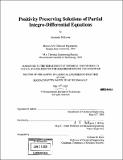| dc.contributor.advisor | Gregory J. McRae. | en_US |
| dc.contributor.author | Lewis, Alexander M. (Alexander McDowell) | en_US |
| dc.contributor.other | Massachusetts Institute of Technology. Dept. of Chemical Engineering. | en_US |
| dc.date.accessioned | 2010-02-09T16:52:01Z | |
| dc.date.available | 2010-02-09T16:52:01Z | |
| dc.date.issued | 2009 | en_US |
| dc.identifier.uri | http://hdl.handle.net/1721.1/51618 | |
| dc.description | Thesis (Ph. D.)--Massachusetts Institute of Technology, Dept. of Chemical Engineering, 2009. | en_US |
| dc.description | "May 15th, 2009." | en_US |
| dc.description | Includes bibliographical references (leaves 246-249). | en_US |
| dc.description.abstract | Differential equations are one of the primary tools for modeling phenomena in chemical engineering. While solution methods for many of these types of problems are well-established, there is growing class of problems that lack standard solution methods: partial integro-differential equations. The primary challenges in solving these problems are due to several factors, such as large range of variables, non-local phenomena, multi-dimensionality, and physical constraints. All of these issues ultimately determine the accuracy and solution time for a given problem. Typical solution techniques are designed to handle every system using the same methods. And often the physical constraints of the problem are not addressed until after the solution is completed if at all. In the worst case this can lead to some problems being over-simplified and results that provide little physical insight. The general concept of exploiting solution domain knowledge can address these issues. Positivity and mass-conservation of certain quantities are two conditions that are difficult to achieve in standard numerical solution methods. However, careful design of the discretizations can achieve these properties with a negligible performance penalty. Another important consideration is the stability domain. The eigenvalues of the discretized problem put restrictions on the size of the time step. For "stiff' systems implicit methods are generally used but the necessary matrix inversions are costly, especially for equations with integral components. By better characterizing the system it is possible to use more efficient explicit methods. | en_US |
| dc.description.abstract | (cont.) This work improves upon and combines several methods to develop more efficient methods. There are a vast number of systems that be solved using the methods developed in this work. The examples considered include population balances, neural models, radiative heat transfer models, among others. For the capstone portion, financial option pricing models using "jump-diffusion" motion are considered. Overall, gains in accuracy and efficiency were demonstrated across many conditions. | en_US |
| dc.description.statementofresponsibility | by Alexander M. Lewis. | en_US |
| dc.format.extent | 249 leaves | en_US |
| dc.language.iso | eng | en_US |
| dc.publisher | Massachusetts Institute of Technology | en_US |
| dc.rights | M.I.T. theses are protected by
copyright. They may be viewed from this source for any purpose, but
reproduction or distribution in any format is prohibited without written
permission. See provided URL for inquiries about permission. | en_US |
| dc.rights.uri | http://dspace.mit.edu/handle/1721.1/7582 | en_US |
| dc.subject | Chemical Engineering. | en_US |
| dc.title | Positivity preserving solutions of partial integro-differential equations | en_US |
| dc.type | Thesis | en_US |
| dc.description.degree | Ph.D. | en_US |
| dc.contributor.department | Massachusetts Institute of Technology. Department of Chemical Engineering | |
| dc.identifier.oclc | 495844867 | en_US |
